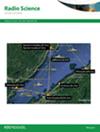Satellite onboard transmitter design with spread spectrum MIMO antenna for 5G wireless networks
IF 1.6
4区 地球科学
Q3 ASTRONOMY & ASTROPHYSICS
引用次数: 0
Abstract
The 5G new era implements standalone satellite communications that support wireless networking systems for future mobile communications by locating multiple satellites in low Earth orbit to provide global coverage of the entire Earth's surface. In this research, a newly found model of a satellite onboard transmitter using a uniform circular array multiple-input multiple-output antenna was designed to operate at a carrier frequency of 12 GHz and derived theoretical equations compared to the real-time scenario. The integration of spread spectrum with multiple-input multiple-output antenna provides an advantage for higher capacity. It has a higher percentage of gain amplification on improving the transmission of electromagnetic power to meet the bandwidth requirement of center operating frequency, and this can transmit over a bandwidth of 1.28 GHz. The proposed satellite onboard transmitter model design aims to minimize the components, increase the speed of operations for higher bandwidth, and transmit large amounts of information to a large group of users. The transmitter can operate for the speed of 1.28 Gbps using pseudo-random code, direct-sequence spread spectrum, quadrature phase shift keying modulation, bandwidth separated in bands for 64 symbols using 128 Chebyshev-type bandpass filter for transmission using 128-element uniform circular array multiple-input multiple-output antenna. The satellite transmitter antenna produces a maximum gain of 14.526 dBi, and a maximum directivity of 17.986 dBi, and the efficiency at 12 GHz is 45.1% for the radiated power at 0.93 mW. This satellite transmitter will interconnect 5G wireless networks for the application of mobile communications complement terrestrial-dependent networks.采用扩频多输入多输出天线的 5G 无线网络卫星星载发射机设计
5G 新时代实现了独立卫星通信,通过在低地球轨道上定位多颗卫星来提供对整个地球表面的全球覆盖,从而支持未来移动通信的无线网络系统。在这项研究中,设计了一种新发现的卫星星载发射机模型,该模型采用了均匀圆阵多输入多输出天线,工作在 12 GHz 的载波频率上,并推导出了与实时场景相比较的理论方程。扩频与多输入多输出天线的整合为更高的容量提供了优势。它在提高电磁功率传输方面具有更高的增益放大比例,以满足中心工作频率的带宽要求,可在 1.28 GHz 的带宽上进行传输。所提出的卫星星载发射机模型设计旨在最大限度地减少组件,提高更高带宽的运行速度,并向大量用户传输大量信息。该发射机采用伪随机码、直接序列扩频、正交相移键控调制,使用 128 元均匀圆阵多输入多输出天线,利用 128 切比雪夫型带通滤波器将带宽分隔为 64 个符号,传输速度可达 1.28 Gbps。卫星发射器天线的最大增益为 14.526 dBi,最大指向性为 17.986 dBi,在 12 GHz 频率下的效率为 45.1%,辐射功率为 0.93 mW。该卫星发射机将实现 5G 无线网络的互联互通,为移动通信应用补充依赖地面的网络。
本文章由计算机程序翻译,如有差异,请以英文原文为准。
求助全文
约1分钟内获得全文
求助全文
来源期刊

Radio Science
工程技术-地球化学与地球物理
CiteScore
3.30
自引率
12.50%
发文量
112
审稿时长
1 months
期刊介绍:
Radio Science (RDS) publishes original scientific contributions on radio-frequency electromagnetic-propagation and its applications. Contributions covering measurement, modelling, prediction and forecasting techniques pertinent to fields and waves - including antennas, signals and systems, the terrestrial and space environment and radio propagation problems in radio astronomy - are welcome. Contributions may address propagation through, interaction with, and remote sensing of structures, geophysical media, plasmas, and materials, as well as the application of radio frequency electromagnetic techniques to remote sensing of the Earth and other bodies in the solar system.
 求助内容:
求助内容: 应助结果提醒方式:
应助结果提醒方式:


